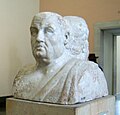사용자:배우는사람/문서:Herma

- For the piano piece by Iannis Xenakis, see Herma (Xenakis).
A Herma, (Greek: ἕρμα, pl ἑρμαῖ) commonly in English herm is a sculpture with a head, and perhaps a torso, above a plain, usually squared lower section, on which male genitals may also be carved at the appropriate height. The form originated in Ancient Greece, and was adopted by the Romans, and revived at the Renaissance in the form of term figures and Atlantes.
In ancient Greece the statues had an apotropaic function and were placed at crossings, country borders and boundaries as protection. Before his role as protector of merchants and travelers, Hermes was a phallic god, associated with fertility, luck, roads and borders. His name comes from the word herma (plural hermai) referring to a square or rectangular pillar of stone, terracotta, or bronze; a bust of Hermes' head, usually with a beard,[1] sat on the top of the pillar, and male genitals adorned the base. The hermai were used as boundary markers on roads and borders. In Athens, they were placed outside houses as apotropes for good luck. [The male genitals would be rubbed or anointed with olive oil to obtain luck].[출처 필요] This superstition persists, for example in the Porcellino bronze boar of Florence (and numerous others like it around the world), where the nose is shiny from being continually touched for good luck or fertility.
Especially in Roman and Renaissance versions, the body was often shown from the waist up. The form was also used for portrait busts of famous public figures, especially writers like Socrates and Plato. Sappho appears on Ancient Greek herms, and anonymous female figures were often used from the Renaissance on, when herms were often attached to walls as decoration.
The trial of Alcibiades[편집]

In 415 BC, on the night before the Athenian fleet was about to set sail for Syracuse during the Peloponnesian War (see Sicilian Expedition), all of the Athenian hermai were vandalized. This was a horribly impious act and many people believed it threatened the success of the expedition. Though it was never proven, the Athenians at the time believed it was the work of saboteurs, either from Syracuse or Spartan sympathizers from Athens itself. In fact, Alcibiades was accused of being the originator of the crime. He denied the accusations and offered to stand trial, but the Athenians did not want to disrupt the expedition any further. His opponents were eager to have Alcibiades' trial in his absence when he could not defend himself. Once he had left on the expedition, his political enemies had him charged and sentenced to death in absentia, both for the mutilation of the herms, and the supposedly related crime of profaning the Eleusinian Mysteries.
Art and popular culture[편집]
The J. Paul Getty museum in Los Angeles has a large collection of Roman Herma boundary marker stones in its stored collection.
In February 2007 and 2008, a group of University of Chicago students fashioned a set of life-size hermai out of ice and placed them around their campus in the middle of the night as a prank.
Gallery[편집]
-
Archaic Greek herm, presumably of Hermes, unusual in that the penis has survived.
-
Herm on an Attic red-figure lekythos, 475–450 BC.
-
A hermaic sculpture of an old man, probably a philosopher. Ai Khanoum, Afghanistan, 2nd century BCE.
-
Small terracotta herm of Hermes
-
Male and female Baroque herms at the Rubenshuis.
-
Art Nouveau or Neo-Baroque herms in Poland
-
Herms with Mannerist antecedents, in A Handbook of Ornament (1898)
See also[편집]
References[편집]
이 문서의 내용은 출처가 분명하지 않습니다. |
- ↑ The image of a youthful, beardless Hermes was a development of the fifth century BCE.
External links[편집]
- Ice Herms, with primary source passages on ancient herms and on the sacrilege trial of Alcibiades, images of ancient herms from sculpture and vase painting, and photos (including a step-by-step guide to the making) of the University of Chicago ice herms







